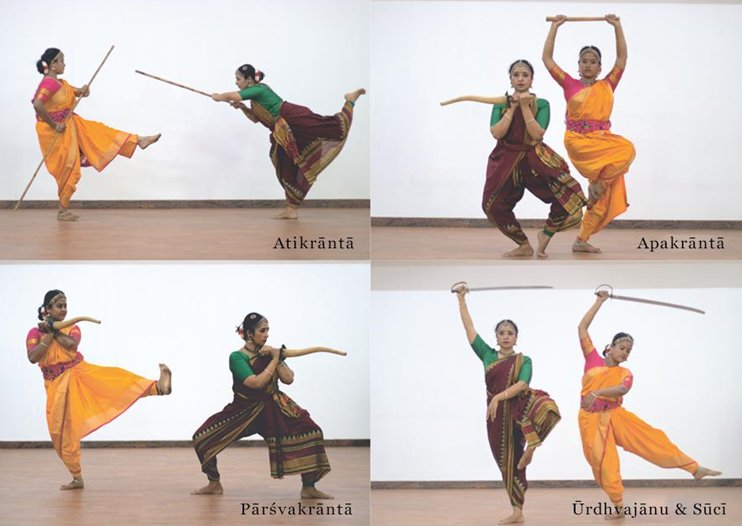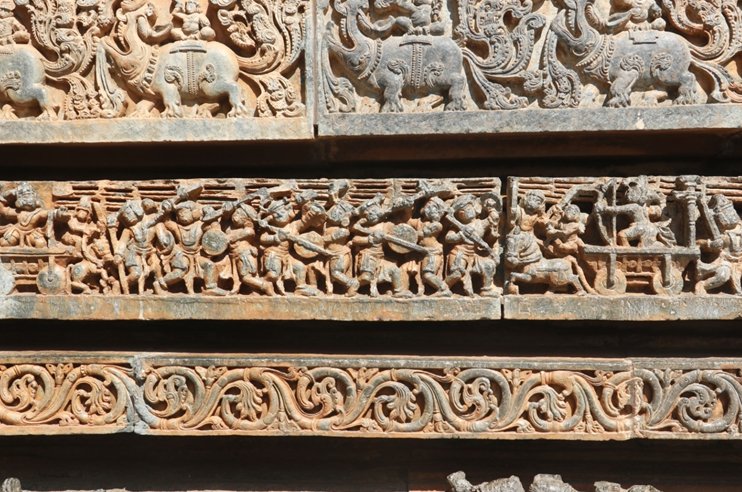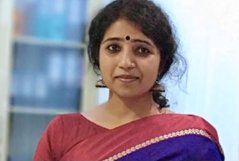
|
 |

|
 |
Mandala Nritta: Techniques of staging war sequences based on Naṭyashastra - Dr. Nancy Abraham e-mail: nancyabraham@rocketmail.com December 3, 2023 Art revives and readapts time and space. Indian performing arts transcends boundaries and enables global platform to communicate human experiences. This study throws light on Maṇḍalas which is the core performing techniques particularly used to stage the war sequences mentioned in Bharatha's Natyashastra. It emphasizes on war movements. Maṇḍala Nritta is a technique to perform war dance and usage of weapons. They are usually performed by movements of feet which are graceful and harmonic. It can be delicate movement of one leg or a combination of the movement of shank, feet and thighs. Bharatha's Natyashastra mentioned only the lower limb movements which are divided into two types, Akasha mandala and bhu mandala or aerial and earthly mandalas. Indian dance research plays a significant role in ancestry of dance movement into the integral part of modern dance world. So texts and commentaries on the one hand and praxis on the other hand were essential to understand India's dance tradition to reconstruct their history. The Naṭyashastra encompasses all that belongs to the Indian tradition of art and aesthetics. It is a Sanskrit treatise on performing arts. The study of Indian art and culture derived through various layers such as theory and its application, oral and textual tradition, ethics and aesthetics, classics and folks (Margi and Desi tradition). "No living art can be held captive within the compass of spoken word. It would be like trying to catch a river in the pot," said Dr. R Satyanarayana, one of the Indian scholars. (Satyanarayana; 1969). A sneak peek into the ancient society and war fairs are dealt with that favor the art form of those timelines. As it's a historical analysis, a timeline identifies the major historical, societal and artistic evidence and gives a visual sense of entire period through sculptures and rock cut paintings. Temple or cave sculptures and paintings provide the information of daily routine of a common man, wars and war tactics of the current society, art movement, story of gods and goddesses, portrayal of Ramayana, Mahabharata panels. Another main source of inscriptions was victory of a king and what they conquered and captured during the war. How they celebrated each victory and what was the social system that prevailed. Study sources of early India can broadly be divided into two categories - literary and archaeological. The whole thing is there, you see. The world of space and time, and matter and energy, the world of creation and destruction, the world of psychology... We (the West) don't have anything remotely approaching such a comprehensive symbol, which is both cosmic and psychological, and spiritual. (Aldous Huxley, 1961) Art history emerges in nineteenth century when assembling national collections of art in Germany and England began while cataloguing and writing the histories of the artworks they were purchasing. Early writing for Westerners on Indian dance began in 1928, when an American enthusiast known as Ragini Devi (also referred to as Sri Ragini) published a small book called Nritanjali: An Introduction to Hindu Dancing. Probably the first book in English on Indian dance, it was mainly a descriptive discourse addressing the divine themes and conscious discipline of Hindu dance. Uday Shankar had, in the 1920s at the British Museum and in the 1930s in India, modeled the poses of Indian sculptures, devising movements that came to an extended form from their positions, using his "discoveries" as a basis for his dance movements. But realizing the depth of this correlation between sculpture and dance, and the antiquity of the relationship, was Dr.Kapila Vatsyayan's contribution to Indian art history. The period between 1935 and 1950 may today be called a period of the evolution of neo- classical dance forms in India. In each aspect textual base was adopted to reconstruct a medieval or an ancient dance form. In the period between 1950 and 1980s, two trends are in evidence. The re-construction of neo classical forms has come to stay; they are accepted as antiquity. They are taught and in the sixties and seventies widely disseminated abroad. Recognizing the importance for dance of India's sculptural art was not a new idea. The earliest extant example of this tradition is the Natyashastra, in which all the performing arts of the time are discussed and in which dancing is a technique for adding beauty of bodily motion to dramatic performances. An ancillary to drama rather than an independent art, dancing carried no meaning and elicited no emotional response. In the work of later writers, its autonomy was recognized as also ability to express thoughts and feelings and it began to be discussed fully in works devoted particularly to it rather than in works on drama or poetics, a clear sign of its growing importance in India's cultural history. War is an intrinsic part of human existence. Man has been waging war either in self-defense or for self enhancement from time immemorial. Hence war is rooted in the human history. To bolster his fighting capabilities he has been learning all the techniques and manufacturing the weapons right from Paleolithic times till today. The authority that the Natyashastra has exerted over all subsequent works on dancing is due not only to its chronological priority but also the range of subjects it included from stage architecture to body movements. Maṇḍalas are the circular movements which are purely originated from Natyashastra period onwards. Scholarly opinion differs as to the date of the work, generally placing it between the 2nd century B C and the 2nd century A D. According to Natyashastra, formations of Cäris into Maṇḍalas have been emphasized in the 12th chapter. Maṇḍalas are used for the discharge of weapons. Maṇḍala Nritta is a war dance. There are 10 aerial maṇḍalas and 10 earthly maṇḍalas. atikräntam vicitrm ca tathä lalitasancarmn/ sücividdhanam dandapadam vihrtälätake tatha// vamaviddham salalitham kräntam cakasahnani tu/ (Unni, 2014: 734- 778) The Maṇḍalas regarded as aerial are enumerated as: (l) Atikränta, (2) Vicitra, (3) Lalltasancara, (4) Sücividdha (5) Dandapäda, (6) Viluta, (7) Alätaka, (8) Vämaviddha, (9) Lalita and (10) Kränta. bhramaraskandite syatamavartam ca tatah param/ samotsaritamapyahuredakakriditam tatha // addtam Shakadasyam ca tatha dhyardhakameva ca/ pistakuttam ca vijneyam tathä casagatam punah// etänyäpi dasoktani bhumiganiha namtah atah param pravaksyami lasanani yathakramam// The earthly Maṇḍalas The earthly Maṇḍalas enumerated as ten are: (1) Bhramara, (2) Äskandita, (3) Ävarta, (4) Samotsärita, (5) Eclakäkridita, (6) Addita, (7) Eakatäsya, (8) Adhyardhaka, (9) Pistakutta and (10) Cäsagata. Above are the commentaries given in Natyashastra to decode Mandala Nritta. Dr. Padma Subrahmanyam had worked immensely to decode and reconstruct the history of karanas and caris. Combination of cari sequences forms Mandala. Natyashastra also describes the usage of weapons in the performances. Offensive and defensive movements can be constructed by using Mandala Nritta techniques. Natyashastra described on lower limb techniques and gave liberty to create or choose the form for artiste on how they want to exhibit the upper body. I tried using kalari weapons and creating the same in my work.  Dance or movements has occupied a central place in educational theory since the times of the ancient philosophers Plato and Aristotle, who believed that dance contributes to aesthetic, moral, and intellectual values as well as to enhancing physical adeptness and overall well-being. Plato asserted, for example, that dance trains the mind and soul to differentiate among those forms of actions, feelings, and ideas capable of producing nobility of character and refinement of the mind. Aristotle ranked dance among the educational activities qualifying as ends or things of value for themselves.  Historical evidence of war sculptures Kulathunga Chola III also known as Chakravarti (1178 to 1218 CE) was the ruler of the Chola Empire who succeeded from Rajaraja Chola II. He gained war against the Hoysala, Pandya of Madurai. He also had the alias Tribhuvanaviradeva and bore the title Tribhuvanachakravarthi. Tribhuvanam temple, one of the last massive temples built a little before 1212 CE by the divine order of Srikanta Shambu's disciple Ishwara Shivan, had a mention of sequence of war dance sculptures where in 28 years of the king's reign, refers to his victories over Pandyas. Art is made of contemplation, but also of penetration. The models create the artist no less than the artist creates the models. Each race contributes something essential to the world's civilization in the course of its own self-expression and self-realization. The character built up in solving its own problems, in the experience of its own misfortunes, is itself a gift which each offers to the world.  Dr. Nancy Abraham is a Bharatanatyam practitioner from Bangalore. She was awarded Ph.D. in Dance from Mysore University under the guidance of Dr. Sheela Sridhar. Her Dance research was mainly on Mandala Nritta and Indian aesthetics. She has associated with Christ University, Bangalore and Kristu Jayanti College as a dance academician and is currently working as an Assistant Professor in SIMATS in performing arts department. Response * Namaste Dr. Nancy. Your article has been written beautifully and clearly, Mandala Nritta has been explained. Thank you for sharing. - Dr. Seema S. Upadhyaya (Dec 3, 2023) Post your comments Pl provide your name and email id along with your comment. All appropriate comments posted with name & email id in the blog will also be featured in the site. |